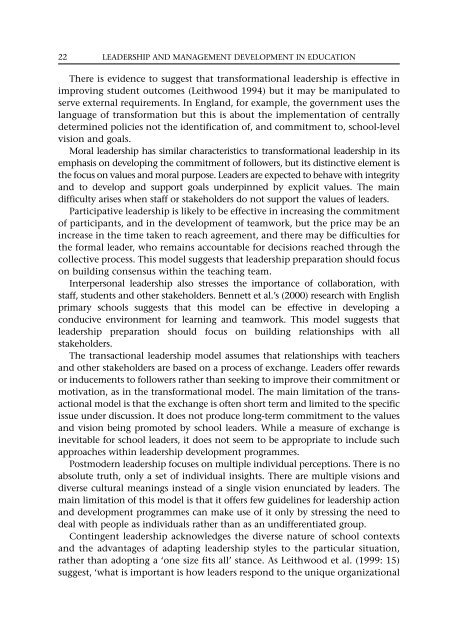Leadership and Management Development in Education (Education ...
Leadership and Management Development in Education (Education ...
Leadership and Management Development in Education (Education ...
You also want an ePaper? Increase the reach of your titles
YUMPU automatically turns print PDFs into web optimized ePapers that Google loves.
22LEADERSHIP AND MANAGEMENT DEVELOPMENT IN EDUCATIONThere is evidence to suggest that transformational leadership is effective <strong>in</strong>improv<strong>in</strong>g student outcomes (Leithwood 1994) but it may be manipulated toserve external requirements. In Engl<strong>and</strong>, for example, the government uses thelanguage of transformation but this is about the implementation of centrallydeterm<strong>in</strong>ed policies not the identification of, <strong>and</strong> commitment to, school-levelvision <strong>and</strong> goals.Moral leadership has similar characteristics to transformational leadership <strong>in</strong> itsemphasis on develop<strong>in</strong>g the commitment of followers, but its dist<strong>in</strong>ctive element isthe focus on values <strong>and</strong> moral purpose. Leaders are expected to behave with <strong>in</strong>tegrity<strong>and</strong> to develop <strong>and</strong> support goals underp<strong>in</strong>ned by explicit values. The ma<strong>in</strong>difficulty arises when staff or stakeholders do not support the values of leaders.Participative leadership is likely to be effective <strong>in</strong> <strong>in</strong>creas<strong>in</strong>g the commitmentof participants, <strong>and</strong> <strong>in</strong> the development of teamwork, but the price may be an<strong>in</strong>crease <strong>in</strong> the time taken to reach agreement, <strong>and</strong> there may be difficulties forthe formal leader, who rema<strong>in</strong>s accountable for decisions reached through thecollective process. This model suggests that leadership preparation should focuson build<strong>in</strong>g consensus with<strong>in</strong> the teach<strong>in</strong>g team.Interpersonal leadership also stresses the importance of collaboration, withstaff, students <strong>and</strong> other stakeholders. Bennett et al.’s (2000) research with Englishprimary schools suggests that this model can be effective <strong>in</strong> develop<strong>in</strong>g aconducive environment for learn<strong>in</strong>g <strong>and</strong> teamwork. This model suggests thatleadership preparation should focus on build<strong>in</strong>g relationships with allstakeholders.The transactional leadership model assumes that relationships with teachers<strong>and</strong> other stakeholders are based on a process of exchange. Leaders offer rewardsor <strong>in</strong>ducements to followers rather than seek<strong>in</strong>g to improve their commitment ormotivation, as <strong>in</strong> the transformational model. The ma<strong>in</strong> limitation of the transactionalmodel is that the exchange is often short term <strong>and</strong> limited to the specificissue under discussion. It does not produce long-term commitment to the values<strong>and</strong> vision be<strong>in</strong>g promoted by school leaders. While a measure of exchange is<strong>in</strong>evitable for school leaders, it does not seem to be appropriate to <strong>in</strong>clude suchapproaches with<strong>in</strong> leadership development programmes.Postmodern leadership focuses on multiple <strong>in</strong>dividual perceptions. There is noabsolute truth, only a set of <strong>in</strong>dividual <strong>in</strong>sights. There are multiple visions <strong>and</strong>diverse cultural mean<strong>in</strong>gs <strong>in</strong>stead of a s<strong>in</strong>gle vision enunciated by leaders. Thema<strong>in</strong> limitation of this model is that it offers few guidel<strong>in</strong>es for leadership action<strong>and</strong> development programmes can make use of it only by stress<strong>in</strong>g the need todeal with people as <strong>in</strong>dividuals rather than as an undifferentiated group.Cont<strong>in</strong>gent leadership acknowledges the diverse nature of school contexts<strong>and</strong> the advantages of adapt<strong>in</strong>g leadership styles to the particular situation,rather than adopt<strong>in</strong>g a ‘one size fits all’ stance. As Leithwood et al. (1999: 15)suggest, ‘what is important is how leaders respond to the unique organizational
















